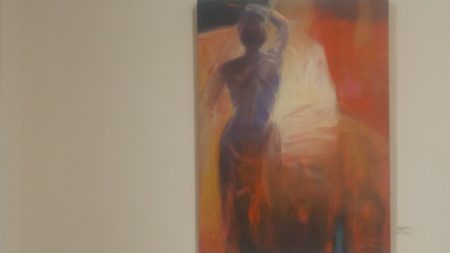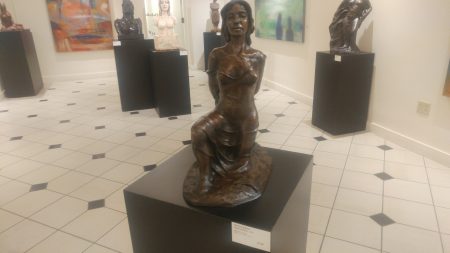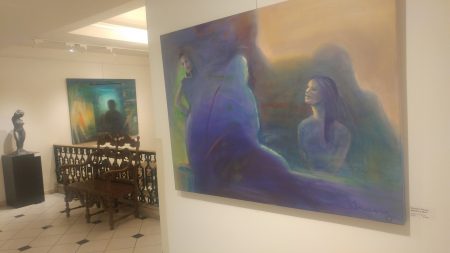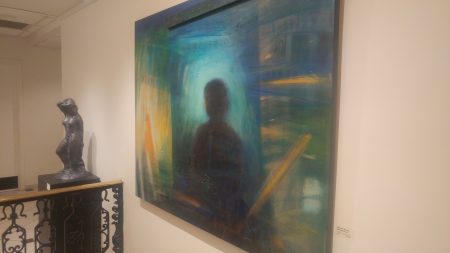A purple figure faces away from me, her strong back standing at attention. One hand raised, shading her eyes as she looks on into a fiery-red dreamscape, ruminating on her path through an abstract terrain.
This is “Woman,” by local abstract painter Eunshin Khang. Khang is one half of the artists being exhibited at the YWCA Women’s Art Gallery. Local sculptor Hei-Kyung Byun’s work makes up the other half of “Women of Strength” — an exhibit running through Sept. 20.
The artistic pairing is complimentary not only in theme, but in space. Khang’s dreamy paintings line the walls, while Byun’s sculptures stand to meet onlookers throughout the middle of the room. All around, the viewer is confronted with the varied faces of womanhood; works bearing titles such as “Moment of Serenity,” “Determination,” “Lost in Thought,” “Quiet Grace,” “Meditation,” “Hope,” “Free Spirit,” “Dreamer,” “Courage,” “Faith,” “Tranquility,” and “Flight.”
One striking curation within the gallery was Khang and Byun’s mirroring depictions of female determination. Both artists contributed works under this title.
Khang’s “Determination” is a flurry of fluid brushstrokes which flow from the graceful sweep of an arm, rather than the contained flick of a wrist. The strokes depict a silhouetted female form, kneeling and raising an arm in triumph. Byun’s “Determination” is a bronze statue of a woman on a pedestal. She, too, appears rising from a kneeling position — looking forward, determined to rise despite the weight of her metallic form.
Another emotionally impactful piece rests unassumingly around a corner of the gallery. Khang’s “Martha and Mary” speaks volumes in a single frame. Within a misty blue dream (where many of Khang’s figures find themselves), three women sit in conversation: a young woman, a woman approaching adulthood, and an elderly woman. The young woman looks upward at the elderly woman with eager revery, light illuminating her curious face. The slightly older woman stands quietly to the side of the older woman. There is a bashfulness about her, as if she is embarrassed to give the older woman the intense attention of the younger woman. But, she still turns an ear towards what the elderly woman is saying, a smirk of quiet respect on her face.
Just above the ornate stairwell of the YWCA, Khang’s painting “Rumination” depicts a dark female form looking away from her canvas. In the space of the gallery, following the figure’s gaze will lead viewers’ eyes directly to Byun’s “Quite Grace” — a curvaceous bronze sculpture, fittingly overlooking the whole exhibit from her solitary corner.
Both Khang and Byun depict the idyllic countenance, the many heads, of the divine feminine spirit: an ever-changing yet ever-clarifying idea. In flux, on a journey toward greater understanding. Two pieces of Khang’s, “Dream 1” and “Dream 2,” at first feel unrelated to the exhibit. But, this idea of an ever-changing understanding of the “whole” of womanhood within the exhibit fits perfectly around this pair. Both “Dream” paintings depict the same abstract objects, but “Dream 2” offers more defined, coming-into-focus forms than “Dream 1,” reminiscent of the way memories of dreams undulate in and out of focus in our waking lives.
–Russell Hausfeld





